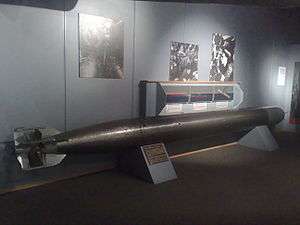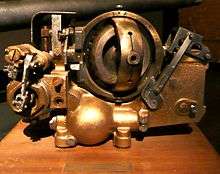G7a torpedo
The G7a(TI) was the standard issue Kriegsmarine torpedo during the early years of World War II. It was a steam-powered design, using a wet heater engine burning decaline, with a typical range of about 7,500 metres (24,600 ft) while running at 40 knots (74 km/h; 46 mph). It was replaced beginning in 1942 by the electrically powered G7e torpedo, which did not leave a trail of bubbles in the water and thus did not reveal the location of the submarine. G7a's remained in service in other roles, including surface ships, until the end of the war.

Design
The G7a (TI) torpedo was 533.4 mm (21 in) in diameter, 7163 mm (23 ft 6 in) in length (with a type Ka or Kb warhead and Pi1 or Pi2 pistol), the warhead holding a charge of approximately 280 kg (617lbs) of so-called Schießwolle 36. It was Kriegsmarine's first operational torpedo (hence "TI" = Torpedo number one), and the standard issue torpedo for all German U-boats and surface torpedo-bearing vessels from ca 1935 to the end of WW2.

The torpedo was of a straight-running unguided design, controlled by a gyroscope. The TI was of variable speed, running a distance of 5,000 m at 81 km/h (5,500 yd at 44kt), 7,500 m at 74 km/h (8,250 yd at 40 kt), and 12,000 m at 55.6 km/h (13,200 yd at 30 kt). The 44 kt setting was used only by torpedo boats like the Schnellboote on torpedoes with a reinforced engine.
The TI was the last naval torpedo of German design in operational use with the traditional standard wet heat method of propulsion. The torpedo was powered by an engine fed by a mixture of compressed air and steam. Decaline fuel was burning in a combustion chamber, creating steam from fresh water. The torpedo's speed was determined by the level of pressure (three settings for 30/40/44 kn) from the low-pressure regulator feeding air to the bottom of the combustion chamber. The resulting superheated steam powered a four cylinder reciprocating engine, in turn powering a pair of contra-rotating propellers.
Though this system of propulsion gave the TI great speed and endurance – the greatest of any production model German torpedo of World War II – it had the distinct disadvantage of being very noisy and leaving a long wake of bubbles, common to most torpedoes of the period, with the exception of the Japanese Type 93 and submarine Type 95, which were fuelled by enriched oxygen. For U-boats, this relegated the TI for use mainly at night, when its wake was least noticeable, so as to not give away the element of surprise and the location of the submarine that fired it. During daytime, the electric torpedoes were favoured.
The TI was initially fitted with a combined mechanical/magnetic exploder, which was inadequately tested (like the U.S. Navy's Mark 14), having never been live fired.[1] In addition, because the G7a's performance had never been assessed, between deep running and premature explosions[2] (both also familiar to the Mark 14),[3] the G7a suffered a thirty percent failure rate early in World War II.[4] The response of the high command, ignoring complaints and blaming the operators,[5] was also common to the U.S. Pacific Fleet's Submarine Force.[6] The problems were so serious, Admiral Dönitz said, "...never before in military history has a force been sent into battle with such a useless weapon."[7]
Use
There is at least one recorded case of a U-boat being bombed based upon her position being given away by a TI's wake. On 14 September 1939, U-30 was attacked by loitering United Kingdom Fairey Swordfish naval bombers when she fired a TI from her stern torpedo tube at the SS Fanad Head. U-30 was undamaged in the attack and served until she was scuttled at the end of the war.
Though the T1 could easily be spotted by surface ships, it remained the torpedo of choice for some U-Boat captains until the release of the G7e(TIII) electric torpedo in 1942, largely due to the inferior performance and tendency of the G7e(TII) (the wakeless electric torpedo available to U-boats from 1939–1942) to fail to detonate, both on proximity and contact fuses.
The TI were also issued in versions with programmed-steering gyroscopes, using the Fat I ladder search pattern and the Lut I or Lut II pattern running for attacking convoys.
Technical data for G7a(TI) torpedo
- Type: Standard, straightrunning torpedo with wet-heater propulsion and whitehead tail
- Design: Ca. 1930
- Operative service in Kriegsmarine: 1938–1945
- Length (prepared for launch with warhead): 7163 mm
- Diameter: 533.4 mm (21")
- Weight (prepared for launch with warhead): 1538 kg
- Charge, warhead: Ca. 280 kg Hexanite
- Boostercharge (Pi1 pistol): 300 g Pentrite
- Minimum angle of impact to detonate (Pi1 pistol, mechanical mode): 16 degrees
- Speed: 30 kn ("Weitschuß", WS) / 40 kn ("Nahschuß", NS) / 44 kn ("Schnellschuß", SS) 1)
- Depthsetting: 1–12 m (TA-I), 1–15 m (TA-II)
- Arming distance (Pi1 pistol): 100 m (black impeller) / 150 m (red impeller) / 300 m (blue impeller) 2)
- Propulsion: 4-cylinder steam engine (powered by a mixture of overheated steam and compressed air)
- Fuel: Decaline
- Power output, engine: 110 Hp (30 kn) / 255 Hp (40 kn) / 350 Hp (44 kn)
- Engine RPM: 1170 (30 kn) / 1280 (40 kn) / 1470 (44 kn)
- Propeller: 2 × 6-blade (contra-rotating) 3)
- Max running distance: 12000 m (30 kn) / 7500 m (40 kn) / 5000 m (44 kn)
- Capacity, air-tank: 676 l (200 kg/cm^2)
- Freshwatercompartment: 57 l
- Fueltank: 14.5 l
- Oiltank (engine): 6.5 l
- Oiltank (low-pressure regulator): 0.3 l
- Steering: Mechanical gyroscope powered by pressurised air (GA VIII) with anglesetting mechanism (+/- 90 degrees from initial course after launch)
- Depthcontrol: Hydrostatic mechanism with pendulum (TA-I or TA-II)
Note 1) 44kn was to be used by S-Boote (problems with initial design led to breakdown on motors running 44 kn, so this setting was banned until the new engine was available). Note 2) Black used only from shore torpedo batteries, red from surface vessels and blue from submarines. Note 3) Early versions had 4-blade propellers.
Post war use: The TI were used post-war by several navies with different modifications and designations (Marina Española: G-7a, Bundesmarine: DM11, Royal Danish Navy: T1T, Royal Norwegian Navy: T1 mod 1). Last known operator was RNoN with the T1 mod 1 (G7a with wire-guidance: Although four modifications to the torpedo were carried out over the years – the last with computerised control in 1992 – the same designation "mod 1" was applied throughout its service). In the RNoN, T1 mod 1 was used from FACs (until 1992), submarines (until the 1980s) and Coastal artillery shore batteries (until 1999).
Other versions:
- G7a(TI) Fat I: TI with Fat I programsteering 1)
- G7a(TI) Lut I: TI with Lut I programsteering 1)
- G7a(TI) Lut II: TI with Lut II programsteering 1)
- G7a(TIü): TI dedicated for use with Schulboote at U-Flotillen. The torpedo was equipped with the older type depth-mechanism, the lead ballast was removed from the water chamber and a special "light" exercise head was fitted (it was empty, i.e. no water and blowing mechanism). This was done to ensure positive buoyancy at the end of the run. Minor adjustments were also done to the air regulators and combustion chamber to lower the temperature of the drive gas (i.e. mixture of steam and pressurized air). These measures lead to a decrease in range, but achieved the overall goal of significantly less damage/losses of torpedoes and a higher number of exercise-shots for the crews.
- G7a(TIü) Lut II: T1ü with Lut II 2)
- G7a(TIV): TI with changed buoyancy (max air pressure reduced from 200 to 100 kg/cm^2) for the Seehund midget submarine, with sinker-mechanism (never fielded).
- G7as: TI with acoustic seeker (never fielded, nor designated a KM torpedonumber)
Note 1) For launch with program setting, speed could only be set to 30 kn. Note 2) For launch with program setting, speed could be set to 30 or 40 kn.
Exercise- and Warheads/pistols used on the TI: Exersiceheads:
- Type 1210 or type 1215 (improved head with dual blow-mechanisms)
Warhead/pistol statutory combinations according to Kriegsmarine regulations:
- Ka, Ka1 or Ka2 with Pi1, Pi1a or Pi1c pistols
- Kc with Pi3 or Pi3c pistols
- Kc1 or Kc2 with Pi3, Pi3a or Pi3c pistols
Warhead/pistol possible (technically) combinations – only on special demand, approved by torpedo-arsenal and with special consideration to depth-settings in order to assure proper function of the pistol:
- Kb or Kb1 with Pi1, Pi1a, Pi1c, Pi2*, Pi2c* or Pi2c* pistols (* only heads with extended pocket)
References
Notes
- Bekker, Cajus. Hitler's Naval War (New York: Zebra, 1977), p.132.
- Bekker, pp.128, 133, and 137.
- Blair, Clay, Jr. Silent Victory (New York: Bantam, 1976), pp.160 & 413.
- Bekker, p.125.
- Bekker, p.125.
- Blair, pp.62 & 361.
- Bekker, quoted p.132.
Sources
- Bekker, Cajus. Hitler's Naval War. New York: Zebra Books/Kensington Publishing Corp., 1977. (Reprints 1974 MacDonald and Jane's 1971 translation of Gerhard Stalling Verlag edition)
- Blair, Clay, Jr. Silent Victory. New York: Bantam, 1976. (Reprints Lippincott 1975 edition)
- Eberhard Rössler. Die Torpedos der deutschen U-Boote (2.ed), 2005 (ISBN 3-8132-0842-7)
- Kriegsmarine (T.V.A.): Technische Dienstvorschrift Nr. 194 Torpedo-Kopf-Pistolen-Tabelle, 1944
- Bundesmarine: Deutsche Unterwasserwaffen - Torpedos, 1967 (German translation of U.S. Navy Ordnance Pamphlet 1673B)
- Bundesmarine: Torpedo Zünder der Deutschen Marine von 1914 bis 1968 mit historischen Rückblick Band 1, ca 1975
- Bundesmarine: TDv 1356/004-20 Teil 2 - Bedienungsanweisung einschlisslich Pflege und Sicherheitsmassnahmen für Torpedo DM11 (G7a), 1965
- Royal Norwegian Navy. SEP-116 Technical manual for Torpedo T1 mod 1, ca 1990 (unofficial - intended as replacement for several regulations like E.12, E.19 etc.)
- Royal Norwegian Navy. E.12 Manual for torpedo T1 mod 1, ca 1950